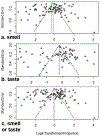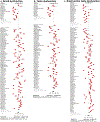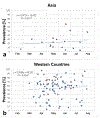Prevalence of Chemosensory Dysfunction in COVID-19 Patients: A Systematic Review and Meta-analysis Reveals Significant Ethnic Differences
- PMID: 32870641
- PMCID: PMC7571048
- DOI: 10.1021/acschemneuro.0c00460
Prevalence of Chemosensory Dysfunction in COVID-19 Patients: A Systematic Review and Meta-analysis Reveals Significant Ethnic Differences
Abstract
A significant proportion of people who test positive for COVID-19 have chemosensory deficits. However, the reported prevalence of these deficits in smell and taste varies widely, and the reason for the differences between studies is unclear. We determined the pooled prevalence of such chemosensory deficits in a systematic review and meta-analysis. We searched the COVID-19 portfolio of the National Institutes of Health for studies that reported the prevalence of smell or taste deficits or both in patients diagnosed with COVID-19. One-hundred-four studies reporting on 38 198 patients qualified and were subjected to a systematic review and meta-analysis. Estimated random prevalence of olfactory dysfunction was 43.0%, that of taste dysfunction was 44.6%, and that of overall chemosensory dysfunction was 47.4%. We examined the effects of age, gender, disease severity, and ethnicity on chemosensory dysfunction. Prevalence of smell or taste dysfunction or both decreased with older age, male gender, and disease severity. Ethnicity was highly significant: Caucasians had a three times higher prevalence of chemosensory dysfunctions (54.8%) than Asians (17.7%). The finding of geographic differences points to two causes that are not mutually exclusive. A virus mutation (D614G) may cause differing infectivity, while at the host level genetic, ethnicity-specific variants of the virus-binding entry proteins may facilitate virus entry in the olfactory epithelium and taste buds. Both explanations have major implications for infectivity, diagnosis, and management of the COVID-19 pandemic.
Keywords: SARS-CoV-2; anosmia; ethnicity; prevalence; smell; taste.
Conflict of interest statement
None of the authors have any proprietary interests or conflicts of interest related to this submission.
Conflicts of Interests
The authors have declared no competing interests.
Figures





Update of
-
Prevalence of Chemosensory Dysfunction in COVID-19 Patients: A Systematic Review and Meta-analysis Reveals Significant Ethnic Differences.medRxiv [Preprint]. 2020 Jun 17:2020.06.15.20132134. doi: 10.1101/2020.06.15.20132134. medRxiv. 2020. Update in: ACS Chem Neurosci. 2020 Oct 7;11(19):2944-2961. doi: 10.1021/acschemneuro.0c00460. PMID: 32587993 Free PMC article. Updated. Preprint.
References
-
- Chung TW, Sridhar S, Zhang AJ, Chan KH, Li HL, Wong FK, Ng MY, Tsang RK, Lee AC, Fan Z, Ho RS, Luk SY, Kan WK, Lam SH, Wu AK, Leung SM, Chan WM, Ng PY, To KK, Cheng VC, Lung KC, Hung IF, Yuen KY. Olfactory Dysfunction in Coronavirus Disease 2019 Patients: Observational Cohort Study and Systematic Review. Open Forum Infect Dis. 2020;7(6):ofaa199. doi: 10.1093/ofid/ofaa199. - DOI - PMC - PubMed
-
- Hannum ME, Ramirez VA, Lipson SJ, Herriman RD, Toskala AK, Lin C, Joseph PV, Reed DR. Objective sensory testing methods reveal a higher prevalence of olfactory loss in COVID-19 positive patients compared to subjective methods: A systematic review and meta-analysis. MedRxiv [Preprint]. 2020. July 06. doi: 10.1101/2020.07.04.20145870. - DOI - PMC - PubMed
Publication types
MeSH terms
Substances
Grants and funding
LinkOut - more resources
Full Text Sources
Medical
Miscellaneous

